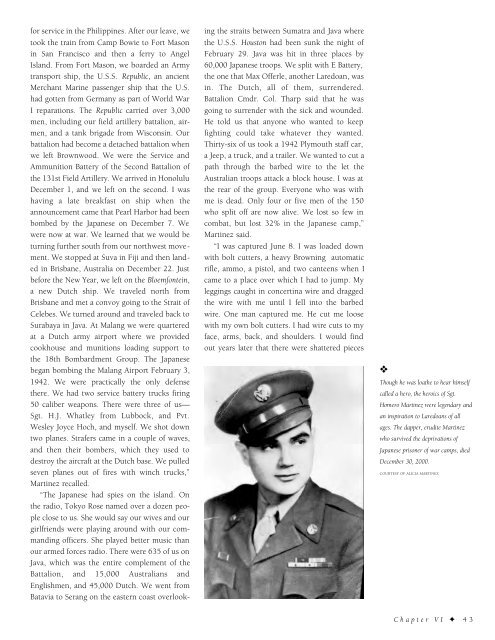Historic Laredo
An illustrated history of the city of Laredo and the Webb County area, paired with the histories of companies, families and organizations that make the region great.
An illustrated history of the city of Laredo and the Webb County area, paired with the histories of companies, families and organizations that make the region great.
Create successful ePaper yourself
Turn your PDF publications into a flip-book with our unique Google optimized e-Paper software.
for service in the Philippines. After our leave, we<br />
took the train from Camp Bowie to Fort Mason<br />
in San Francisco and then a ferry to Angel<br />
Island. From Fort Mason, we boarded an Army<br />
transport ship, the U.S.S. Republic, an ancient<br />
Merchant Marine passenger ship that the U.S.<br />
had gotten from Germany as part of World War<br />
I reparations. The Republic carried over 3,000<br />
men, including our field artillery battalion, airmen,<br />
and a tank brigade from Wisconsin. Our<br />
battalion had become a detached battalion when<br />
we left Brownwood. We were the Service and<br />
Ammunition Battery of the Second Battalion of<br />
the 131st Field Artillery. We arrived in Honolulu<br />
December 1, and we left on the second. I was<br />
having a late breakfast on ship when the<br />
announcement came that Pearl Harbor had been<br />
bombed by the Japanese on December 7. We<br />
were now at war. We learned that we would be<br />
turning further south from our northwest movement.<br />
We stopped at Suva in Fiji and then landed<br />
in Brisbane, Australia on December 22. Just<br />
before the New Year, we left on the Bloemfontein,<br />
a new Dutch ship. We traveled north from<br />
Brisbane and met a convoy going to the Strait of<br />
Celebes. We turned around and traveled back to<br />
Surabaya in Java. At Malang we were quartered<br />
at a Dutch army airport where we provided<br />
cookhouse and munitions loading support to<br />
the 18th Bombardment Group. The Japanese<br />
began bombing the Malang Airport February 3,<br />
1942. We were practically the only defense<br />
there. We had two service battery trucks firing<br />
50 caliber weapons. There were three of us—<br />
Sgt. H.J. Whatley from Lubbock, and Pvt.<br />
Wesley Joyce Hoch, and myself. We shot down<br />
two planes. Strafers came in a couple of waves,<br />
and then their bombers, which they used to<br />
destroy the aircraft at the Dutch base. We pulled<br />
seven planes out of fires with winch trucks,”<br />
Martinez recalled.<br />
“The Japanese had spies on the island. On<br />
the radio, Tokyo Rose named over a dozen people<br />
close to us. She would say our wives and our<br />
girlfriends were playing around with our commanding<br />
officers. She played better music than<br />
our armed forces radio. There were 635 of us on<br />
Java, which was the entire complement of the<br />
Battalion, and 15,000 Australians and<br />
Englishmen, and 45,000 Dutch. We went from<br />
Batavia to Serang on the eastern coast overlooking<br />
the straits between Sumatra and Java where<br />
the U.S.S. Houston had been sunk the night of<br />
February 29. Java was hit in three places by<br />
60,000 Japanese troops. We split with E Battery,<br />
the one that Max Offerle, another <strong>Laredo</strong>an, was<br />
in. The Dutch, all of them, surrendered.<br />
Battalion Cmdr. Col. Tharp said that he was<br />
going to surrender with the sick and wounded.<br />
He told us that anyone who wanted to keep<br />
fighting could take whatever they wanted.<br />
Thirty-six of us took a 1942 Plymouth staff car,<br />
a Jeep, a truck, and a trailer. We wanted to cut a<br />
path through the barbed wire to the let the<br />
Australian troops attack a block house. I was at<br />
the rear of the group. Everyone who was with<br />
me is dead. Only four or five men of the 150<br />
who split off are now alive. We lost so few in<br />
combat, but lost 32% in the Japanese camp,”<br />
Martinez said.<br />
“I was captured June 8. I was loaded down<br />
with bolt cutters, a heavy Browning automatic<br />
rifle, ammo, a pistol, and two canteens when I<br />
came to a place over which I had to jump. My<br />
leggings caught in concertina wire and dragged<br />
the wire with me until I fell into the barbed<br />
wire. One man captured me. He cut me loose<br />
with my own bolt cutters. I had wire cuts to my<br />
face, arms, back, and shoulders. I would find<br />
out years later that there were shattered pieces<br />
❖<br />
Though he was loathe to hear himself<br />
called a hero, the heroics of Sgt.<br />
Homero Martinez were legendary and<br />
an inspiration to <strong>Laredo</strong>ans of all<br />
ages. The dapper, erudite Martinez<br />
who survived the deprivations of<br />
Japanese prisoner of war camps, died<br />
December 30, 2000.<br />
COURTESY OF ALICIA MARTINEZ<br />
Chapter VI ✦ 43
















